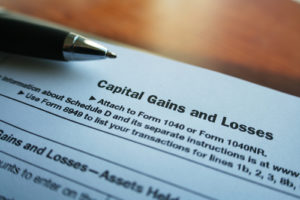Use This Bear Market to Collect Free Money

- Every wealth builder should be focused on maximizing their total return, which means minimizing their taxes.
- Today, Alexander Green explains how the recent bear market created an important opportunity for investors to do exactly that.
Editor’s Note: Concerned about making smart investment moves in the midst of the coronavirus? Alexander Green is here for you. Make sure you read today’s article about minimizing your taxes with capital losses and check out his latest video update.
– Christina Grieves, Senior Managing Editor
In a headline like the one above, the words free money are usually in quotation marks, indicating the phrase is metaphorical, not literal.
There are no quotation marks today.
That’s because I want to show you how to collect actual free money.
I’m not referring to the financial aid that the federal government is sending out, although Uncle Sam will play a role.
Let me explain…
In my last column, I noted that every investor’s long-term goal should be the same: maximum total return.
How is your total return calculated? Here’s a simple formula: Total Return = Return on Invested Capital + Dividends and Interest – Investment Costs – Taxes.
Today let’s focus on that last item.
In my former life as a money manager, I was surprised how many investors are oblivious to the tax consequences of their investment decisions.
Big mistake.
If you aren’t careful, you can turn many tens of thousands of dollars over to the IRS – that weren’t required.
(Indeed, the typical high net worth investor pays a million dollars in local, state and federal taxes well before he or she accumulates a net worth of a million dollars or more.)
It makes sense to tax-manage your portfolio. And one way to do that is to harvest tax losses.
In the 11-year bull market that just ended, we rarely had enough capital losses to offset all our realized capital gains.
But the ferocious bear market of the last few weeks has handed you an opportunity. (Even if it doesn’t feel like it.)
You not only have the chance to buy undervalued stocks. (We’re doing plenty of that in my Oxford Communiqué portfolios and VIP Trading Services.)
You also can make lateral moves that will save you many thousands of dollars and cost you nothing.
Here’s how it works. The IRS allows you to offset realized capital gains – and up to $3,000 annually in earned income – by realizing capital losses (i.e., selling securities for less than what you paid for them).
Historically, there have been three objections to this:
- The investor didn’t want to miss a rebound in the market.
- The investor wasn’t sitting on realized gains to offset.
- The investor didn’t want to pay the trading costs.
The third is history. Discount brokers across the board have taken commissions to zero.
The second is irrelevant. Even if you’re not sitting on a ton of realized capital gains at the moment, you will have them in the future.
(And realized capital losses carry forward indefinitely. There is no expiration date.)
So let’s consider the last remaining concern: You may miss out on a market rebound.
If you own index funds or ETFs – which should form the foundation of your investment program – you can sell the funds you own at a loss and replace them immediately with different but virtually identical funds.
For example, you can sell the iShares Core S&P 500 ETF (NYSE: IVV) for a loss and immediately replace it with the Vanguard S&P 500 ETF (NYSE: VOO).
The two funds hold the same securities in the same percentages.
The only real difference is the iShares ETF has a microscopic annual expense ratio of 0.04%, while the Vanguard ETF has a near-invisible expense ratio of 0.03%.
Since the funds are different – even though their benchmark and annual returns are the same – they do not run afoul of the wash-sale rule, which prevents an investor from taking a loss for tax purposes without waiting 30 days to buy the same security back.
You can also do this with various sectors in your portfolio.
For instance, you can realize a loss in the Utilities Select Sector SPDR Fund (NYSE: XLU) and immediately put the proceeds into the Vanguard Utilities ETF (NYSE: VPU).
Or you can sell the Energy Select Sector SPDR Fund (NYSE: XLE) and immediately replace it with the Vanguard Energy ETF (NYSE: VDE).
You can even pull this off with some stocks.
An investor might take a loss in Exxon Mobil (NYSE: XOM) and replace it with Chevron (NYSE: CVX), for example. Or sell United Airlines (Nasdaq: UAL) and replace it with Delta Air Lines (NYSE: DAL). Or sell AT&T (NYSE: T) and replace it with Verizon (NYSE: VZ).
Unlike with ETFs, you will have variability in the future returns of individual stocks, of course. But companies in the same sector tend to rise and fall in tandem.
Why is it smart to switch now? Five reasons.
For starters, we’ve just had the fastest bear market in history. Second, it costs nothing. Third, you don’t risk being out of the market – or a sector – during a rebound. Fourth, you will lower the cost basis on your investments.
And fifth, you are generating free money – no quotation marks – because you will save thousands of dollars in future taxes on income and capital gains.
After the market rebounds, this opportunity will be lost.
So do it now.
Good investing,
Alex







